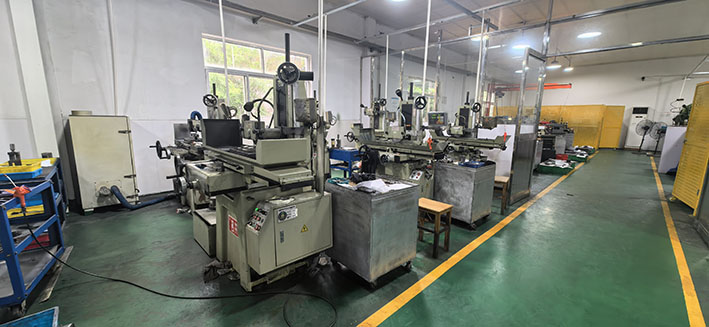
1、 Basic concepts of hardware molds and stamping molds
Hardware molds are molds used to manufacture various metal parts, while stamping molds are molds that use pressure processing methods to manufacture metal sheets.
2、 Construction and Materials for Hardware Molds and Stamping Molds
1. Hardware mold: generally composed of mold seat, mold base, mold core, slider, ejector pin, screw and other components. The materials used are mostly high-speed steel, hard alloy, alloy steel, etc.
2. Stamping die: The basic structure includes an upper die seat, a lower die seat, a release plate, a concave die, a convex die, etc.
Stamping molds are mostly made of hard alloys, tungsten steel, and other materials, which can withstand different pressures and temperatures.
3、 The manufacturing process of hardware molds and stamping molds
1. Manufacturing process of hardware molds: According to the design drawings, CNC machine tools are used for rough machining, followed by precision machining of semi-finished products, and finally heat treatment of the products.
The product after heat treatment needs to undergo surface treatment to improve surface hardness and corrosion resistance.
2. Stamping mold manufacturing process: During the design phase, factors such as pressure transmission, material flow, and part accuracy need to be fully considered.
Pre stretching, cutting, and stretching steps are required during the manufacturing process. For large parts, multiple stretching and multiple processes need to be considered.
4、 Application fields of hardware molds and stamping molds
1. Hardware molds: widely used in fields such as mechanical manufacturing, automotive manufacturing, and home appliance manufacturing.
For example, die-casting molds used to manufacture various gear and shaft parts, as well as punching molds used to produce metal parts such as water pipe joints and electrical joints.
2. Stamping dies: mainly used in fields such as automobile manufacturing, electronic communication, and home appliance manufacturing.
Stamping processing of large metal sheets such as car covers, frames, and carriages, as well as stamping production of precision metal parts such as mobile phone casings and TV back covers.
5、 Advantages and disadvantages of hardware molds and stamping molds
1. Hardware molds: characterized by high strength, high precision, and long lifespan. But the manufacturing process is relatively complex and the cost is high.
Suitable for large-scale production and occasions with high requirements for part accuracy and quality.
2. Stamping molds: have advantages such as high efficiency and low cost.
Suitable for producing large quantities of metal sheet parts, especially in the fields of automotive manufacturing and home appliance manufacturing, it has a wide range of applications.
However, the design and manufacturing of stamping molds are difficult and require high skills from operators.
6、 The development trend of hardware molds and stamping molds
1. Hardware molds: With the development of manufacturing industry and the improvement of technological level, hardware molds will develop towards high precision, high strength, and long service life.
At the same time, the introduction of new materials will further improve the performance and service life of hardware molds.
2. Stamping dies: With the rapid development of industries such as automobiles and home appliances, the demand for stamping dies will continue to increase.
In the future, stamping dies will pay more attention to the application of digital and intelligent technologies to improve production efficiency and accuracy.
Summary: There are significant differences in manufacturing processes and applications between hardware molds and stamping molds.
Hardware molds are mainly used for producing various metal parts, with characteristics such as high precision and long service life, suitable for large-scale production and occasions with high requirements for part quality;
Stamping molds are mainly used for producing metal sheet parts, with advantages such as high efficiency and low cost, and are widely used in fields such as automotive and home appliance manufacturing.
In practice, users should choose the appropriate mold type according to their production needs.